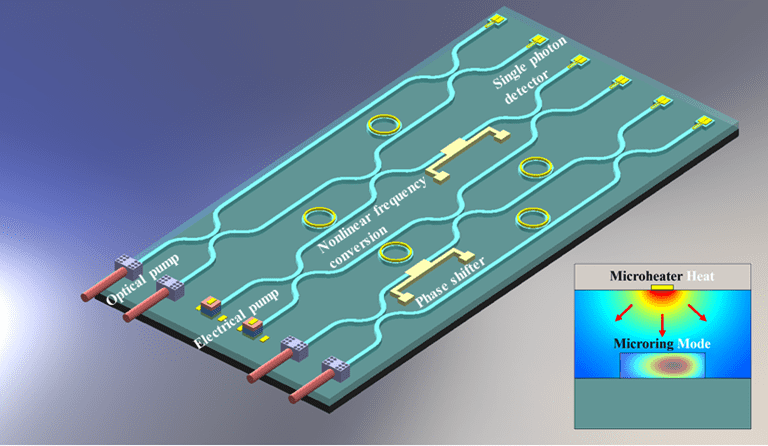Oct 4 2019
A new silicon carbide (SiC) photonic integrated chip recently developed by scientists can be thermally tuned by applying an electric signal.
 Researchers created the first thermally tunable optical switch using a silicon carbide-on-insulator platform. The schematic image shows their concept for a quantum photonics integrated circuit chip that includes the circular microring resonators and microheaters reported in Optics Letters. The inset shows the temperature and electric field distributions at the cross-section of a microring resonator heated by a microheater. (Image credit: Ali Adibi, Georgia Institute of Technology)
Researchers created the first thermally tunable optical switch using a silicon carbide-on-insulator platform. The schematic image shows their concept for a quantum photonics integrated circuit chip that includes the circular microring resonators and microheaters reported in Optics Letters. The inset shows the temperature and electric field distributions at the cross-section of a microring resonator heated by a microheater. (Image credit: Ali Adibi, Georgia Institute of Technology)
In the future, this latest method could be used for producing a broad range of reconfigurable devices like tunable optical couplers and phase-shifters required for quantum data processing and networking applications.
Although silicon is used in a majority of the computer and optical chips, SiC is attracting a great deal of attention because its mechanical, electrical, and thermal properties are better than those of silicon. SiC is also biocompatible and operates from the visible to infrared wavelengths.
In Optics Letters—The Optical Society (OSA) journal—a research team headed by Ali Adibi from the Georgia Institute of Technology has described how an optical device, known as a microring resonator, and a microheater were integrated onto a SiC chip. The achievement signifies the world’s first thermally tunable and fully integrated SiC optical switch operating at near-infrared wavelengths.
Devices such as the one we demonstrate in this work can be used as building blocks for next-generation quantum information processing devices and to create biocompatible sensors and probes.
Xi Wu, Study First Author, Georgia Institute of Technology
In quantum communication and computing applications, SiC is specifically appealing because its defects can be optically regulated and exploited as quantum bits, or qubits for short.
In addition, when it comes to solving specific issues, quantum communication and quantum computing may be considerably faster than conventional computing. This is because the information is encoded in qubits that can exist in any combination of two states simultaneously. This makes it possible to carry out several processes at the same time.
Wafer-Level Manufacturing
The latest study is based on the scientists’ earlier development of a platform called crystalline SiC-on-insulator. This platform can resolve certain fragility and other disadvantages of earlier reported SiC platforms and, at the same time, offer a simple and dependable way of integrating into electronic devices.
“The SiC-on-insulator platform our group pioneered is similar to the silicon-on-insulator technology widely used in semiconductor industry for a variety of applications,” stated Tianren Fan, a part of the research group.
It enables wafer-level manufacturing of SiC devices, paving the way toward commercialization of integrated photonic quantum information processing solutions based on SiC.
Ali A. Eftekhar, Research Team Member, Georgia Institute of Technology
In order to fully manipulate the special capabilities of the novel platform, the researchers should be able to adjust its optical characteristics. This approach would enable the use of a single chip-based structure to provide varied functions. To achieve this, the scientists used the thermo-optic effect in which a material’s optical properties are changed by modifying its temperature—for example, refractive index.
With the help of the crystalline SiC-on-insulator technology, the team started to develop microring resonators, which are very small ring-shaped optical cavities. In every resonator, specific wavelengths of light, known as its resonance wavelengths, moving around the ring will accumulate strength via constructive interference.
Subsequently, the microring resonator can be used to regulate the phase and amplitude of the light in a waveguide combined to it. The scientists also constructed electric heaters on top of the microring resonators to produce a tunable resonator with excellent control.
When the integrated microheater is applied with an electric current, the temperature of the SiC microring increases locally, thus causing variations in its resonant wavelengths. This can be attributed to the thermo-optic effect.
Testing the Integrated Device
The scientists applied varied levels of electrical power to test the performance of the developed integrated microring resonators as well as the microheaters. Then, they measured the optical transmission of the waveguide connected to the microring resonator.
Their outcomes demonstrated high-quality resonators with low-power thermal tunability can be achieved through a powerful device that can be developed using present semiconductor foundry processes.
Combined with other unique features of our crystalline SiC-on-insulator platform, these high-quality devices have the basic requirements for enabling new chip-scale devices that operate in a wide range of wavelengths.
Ali Adibi, Team Lead, Georgia Institute of Technology
Adibi continued, “This chip-scale tunability is essential for performing quantum operations necessary for quantum computing and communication. In addition, because of the biocompatibility of SiC, it could be very useful for in vivo biosensing.”
The team is currently working to develop elements with the crystalline SiC-on-insulator platform for quantum photonic integrated circuits, such as single-photon detectors, single-photon sources, and on-chip pump lasers that can be utilized with the tunable microring resonator to produce a completely functional chip for sophisticated optical quantum computing.
The research is the result of three years of intense studies dedicated to developing a reliable hybrid platform that has significantly enhanced SiC material characteristics and then using it for creating novel devices. The study was vastly contributed by Xi Wu, Tianren Fan, and Ali A. Eftekhar in Ali Adibi’s research team.
Hesam Moradinejad, a former member of Adibi’s research team, also contributed to the development of the platform (published previously). The study was mainly funded by the Air Force Office of Scientific Research (AFOSR) under grant number FA9550-15-1-0342 (G. Pomrenke).